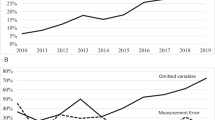Abstract
Analyses of the welfare system generally examine one of five competing models: (1) The work disincentive model; (2) the human capital model; (3) the macroeconomic model; (4) the public choice model; or (5) the cost-of-job-loss model. This paper employs the Granger causality concept and the multiple-rank F statistic to test the implications of all five of these models simultaneously. The results offer modest support to all but the macroeconomic model. The relationships among welfare benefits, caseloads, and labor market conditions appear to be too complex to be fully captured by a single model.
Similar content being viewed by others
References
Anderson, G. (1987). Welfare programs in the rent-seeking society.Southern Economic Journal 54(2): 377–386.
Bassi, L. (1990). Employment and welfare participation among women.Economic Inquiry 28: 222–238.
Bowles, S. (1985). The production process in a competitive economy: Walrasian, Neo-Hobbesian, and Marxian models,American Economic Review, 75(1): 16–36.
Caines, P., Keng, C. and Sethi, S. (1981). Causality analysis and multivariate autoregressive modelling with an application to supermarket sales analysis,Journal of Economic Dynamics (August): 267–298.
Choi, B. (1992).ARMA Model Identification, New York: Springer-Verlag.
Conover, W. and Iman, R. (1982). Analysis of covariance using the rank transformation,Biometrics, 38: 715–724.
Danziger, S., Haveman, R. and Plotnick, R. (1981). How income transfer programs affect work, savings, and the income distribution: A critical review.Journal of Economic Literature 19: 975–1028.
Darity, W. and Myers, S. (1984). Does welfare dependency cause female headship? The case of the black family,Journal of Marriage and the Family (November): 765–779.
Dickey, D. and Fuller, W. (1981). Likelihood ratio statistics for autoregressive time series with a unit root,Econometrica 49: 1057–1063.
Duncan, G. (1984).Years of Poverty, Years of Plenty, Institute for Social Research: Ann Arbor, Michigan.
Franklin, B. (1776).On the Price of Corn, and the Management of the Poor.
Geweke, J. and Meese, R. (1981). Estimating regression models of finite but unknown order,International Economic Review 22: 55–70.
Granger, C.W.J. (1969). Investigating causal relations by econometric models and cross-spectral methods.Econometrica 34: 424–438.
Hamermesh, D. and Johannes, J. (1985). “Food Stamps as money: The macroeconomics of a transfer program,’Journal of Political Economy 93: 205–213.
Holmes, J. and Hutton, P. (1988). A functional-form, distribution-free alternative to parametric analyses of Granger causal models,Advances in Econometrics 7: 211–225.
Holmes, J. and Hutton, P. (1992). A new test of money-income causality,Journal of Money, Credit, and Banking 23(3): 338–355.
Inman, R. (1978). Testing political economy's ‘as if’ proposition: Is the median voter really decisive?Public Choice 33: 45–65.
Leffler, K. (1978). Minimum wages, welfare, and wealth transfers to the poor.Journal of Law and Economics 201(2): 476–494.
Moffitt, R. (1983). An economic model of welfare stigma,American Economic Review 73: 1023–1035.
Moffitt, R. (1987). Historical growth in participation in Aid to Families with Dependent Children: Was there a structural shift?Journal of Post Keynesian Economics IX(3): 347–363.
Moffitt, R. (1989). Estimating the value of in-kind transfers: The case of Food Stamps,Econometrica 57(2): 385–409.
Murray, C. (1984).Losing Ground: American Social Policy, 1950–1980. Basic Books, New York.
Nelson, C. and Kang, H. (1984). Pitfalls in the use of time as an explanatory variable in regression,Journal of Business and Economic Statistics 2: 73–82.
Nelson, C. and Plosser, C. (1982). Trends and random walks in macroeconomic time series: Some evidence and implications,Journal of Monetary Economics 10: 139–162.
Olejnik, S. and Algina, J. (1985). A review of nonparametric alternatives to analysis of covariance,Evaluation Review 9: 51–83.
Olson, M. (1971).The Logic of Collective Action: Public Goods and the Theory of Groups: Harvard University Press, Cambridge.
Pierce, D. and Haugh, L. (1977). Causality in temporal systems: Characterizations and a survey.Journal of Econometrics 5: 265–293.
Rank, M. (1989). Fertility among women on welfare: Incidence and determinants.American Sociological Review 54(2): 296–304.
Sims, C. (1972). Money, income and causality.American Economic Review 62: 540–552.
Schor, J. and S. Bowles (1987). Employment rents and the incidence of strikes.Review of Economics and Statistics 69(4): 177–184.
Smith, P. (1993). Welfare as a cause of poverty: A time series analysis,Public Choice 75: 157–170.
Thorton, D. and Batten, D. (1985). Lag-length selection and tests of Granger causality between money and income,Journal of Money, Credit, and Banking 17: 164–78.
Author information
Authors and Affiliations
Rights and permissions
About this article
Cite this article
Shah, P.J., Smith, P.K. Do welfare benefits cause the welfare caseload?. Public Choice 85, 91–105 (1995). https://doi.org/10.1007/BF01047904
Accepted:
Issue Date:
DOI: https://doi.org/10.1007/BF01047904



